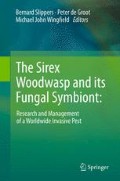Abstract
In Japan seven species of Siricinae have been recorded in four genera, namely Sirex, Urocerus, Xeris and Xoanon. The fungal symbionts of woodwasps in the genera of Sirex, Urocerus and Xoanon are all in the genera Amylostereum. We found that A. areolatum was carried by Sirex nitobei and Xoanon matsumurae, while A. laevigatum was the symbiont of Urocerus antennatus and U. japonicus in Japan. In this chapter, we present an overview of Siricid woodwasps and their fungal symbionts with a specific focus on those occurring in Japan.
Access this chapter
Tax calculation will be finalised at checkout
Purchases are for personal use only
References
Benson RB (1951) Hymenoptera – Symphyta (section a). Handbooks for the identification of British insects. Royal Entomological Society of London, London
Boidin J, Lanquetin P (1984) Le genre Amylostereum (Basidiomycetes) intercompatibilites partielle entre especes allopatriques. Bull Soc Mycol France 100:211–236
Bradley JC (1913) The Siricidae of North America. J Ent Zool 5:1–36
Breitenbach J, Kranzlin F (1986) Fungi of Switzerland, vol 2. Non-gilled fungi. Verlag Mykologia, Lecerne
Chamuris G (1988) The non-stipitate stereoid fungi in the northeastern United States and adjacent Canada. Mycol Mem 14:41–45
Eriksson J, Ryvarden L (1973) The Corticiaceae of North Europe, vol 2. Fungiflora, Oslo
Eriksson J, Hjortstam K, Ryvarden L (1978) The Corticiaceae of North Europe, vol 5. Fungiflora, Oslo
Francke-Grosmann H (1939) Uber das Zusammenlebeb von Holzwespen (Siricidae) mit Pilzen. Z Angew Ent 25:647–680
Fukuda H, Kajimura H, Hijii N (1993) Fecundity of the woodwasp, Sirex nitobei Matsumara, in relation to its body size. J Jpn For Soc 75:405–408
Fukuda H (1997) Resource utilization and reproductive strategy of three woodwasp species (Hymenoptera: Siricidae). Nogoya Univ For Sci 16:23–73
Fukuda H, Hijii N (1997) Reproductive strategy of a woodwasp with no fungal symbionts, Xeris spectrum (Hymenoptera: Siricidae). Oecologia 112:551–556
Furniss RL, Carolin VM (1977) Western forest insects. USDA For Serv Misc Publ 1339:453–457
Gaut IPC (1970) Studies of siricids and their fungal symbionts. PhD thesis, University of Adelaide, Australia
Ginns J, Lefebvre MNL (1993) Lignicolous corticioid fungi (Basidiomycota) of North America, systematics, distribution, and ecology. Mycol Mem 19:21
Hosoda K, Onagamitsu J, Inada T, Sano A, Kon J, Kato T, Hougen T, Inoue M, Sudo S, Sugimoto H, Takemoto M, Miyata H, Yoshimoto K (2005) Study on control methods against the damage of discoloration caused by horntails. For Pest 54:3–14
Kanemitsu K (1978) Woodwasps and their hymenopterous parasitoids in Japanese conifers. Kontyu Tokyo 46:498–508
Kukor JJ, Martin MM (1983) Acquisition of digestive enzymes by siricid woodwasps from their fungal symbiont. Science 220:1161–1163
Kobayashi T, Sasaki K, Enda N (1978) Correlation between Sirex nitobei and Amylostereum areolatum, associated with the death of Japanese pine trees during winter season. J Jpn For Soc 60:405–411
Madden JL (1988) Sirex in Australia. In: Berrymann AA (ed) Dynamics of forest insect populations: patterns, causes, implications. Plenum Press, New York/London
Martin MM (1984) The role of ingested enzymes in the digestive process of insects. In: Anderson AD, Rayner ADM, Walton DWH (eds) Invertebrate-microbial interactions. Cambridge University Press, London
Miyata H (1999) Damage of wood discoloration caused by Urocerus japonicus in Kochi prefecture. Ringyo-to-yakuzai 147:13–18
Miyata H, Kato T, Yoshioka S, Fukuhara N, Hosoda K, Hougen T, Inoue M, Sudo S, Okubo M, Inada T, Onagamitsu J (2001) States of the damage of discoloration caused by horntails and survey of control methods against the damage. For Pest 50:105–113
Morgan FD (1968) Bionomics of Siricidae. Annu Rev Entomol 13:239–256
Okuda M (1989) Urocerus japonicus. Ringyo-to-yakuzai 108:1–8
Sano A (1992) Urocerus japonicus. Ringyo-to-yakuzai 122:1–8
Sato S, Maeto K (2006) Attraction of female Japanese horntail Urocerus japonicus (Hymenoptera: Siricidae) toα-pinene. Appl Entomol Zool 41:317–323
Shibata E (1984) Injury of polished logs of Japanese cedar, Cryptomeria japonica, by Urocerus japonicus. For Pest 33:12–14
Slippers B, Wingfield MJ, Wingfield BD, Coutinho TA (2000) Relationships among Amylostereum species associated with siricid woodwasps inferred from mitochondrial ribosomal DNA sequences. Mycologia 92:955–963
Slippers B, Wingfield BD, Coutinho TA, Wingfield MJ (2002) DNA sequence and RFLP data reflect geographical spread and relationships of Amylostereum areolatum and its insect vectors. Mol Ecol 11:1845–1854
Tabata M, Abe Y (1997) Amylostereum laevigatum associated with the Japanese horntail, Urocerus japonicus. Mycoscience 38:421–427
Tabata M, Abe Y (1999) Amylostereum laevigatum associated with a horntail, Urocerus antennatus. Mycoscience 40:535–539
Tabata M, Harrington TC, Wei C, Abe Y (2000) Molecular phylogeny of species in the genera of Amylostereum and Echinodontium. Mycoscience 41:585–593
Takeuchi K (1962) Insecta Japonica, Hymenoptera: Siricidae, ser 2 part 2. Hokuryukan, Tokyo
Terashita T (1970) A Basidiomycete symbiotic to a siricid in Japan. J Jpn For Soc 52:313–316
Thomsen IM (1998) Characters of fruitbodies, basidiospores and cultures useful for recognizing Amylostereum areolatum and A. chailletii. Mycotaxon 69:419–428
Vasiliauskas R (1999) Spread of Amylostereum areolatum and A. chailletii decay in living stems of Picea abies. Forestry 72:95–102
Vasiliauskas R, Johannesson H, Stenlid J (1999) Molecular relationships within the genus Amylostereum as determined by internal transcribed spacer sequences of the ribosomal DNA. Mycotaxon 71:155–161
Yamada T, Okuda K (1987) Wood discoloration of hinoki and sugi living trees inoculated with Amylostereum sp. symbiotic to the Japanese horntail (Urocerus japonicus Smith). Trans Ann Mtg Jpn For Soc 98:515–516
Acknowledgements
We thank Prof. T.C. Harrington of Iowa State University for providing useful information.
Author information
Authors and Affiliations
Corresponding author
Editor information
Editors and Affiliations
Rights and permissions
Copyright information
© 2012 Springer Science+Business Media B.V.
About this chapter
Cite this chapter
Tabata, M., Miyata, H., Maeto, K. (2012). Siricid Woodwasps and Their Fungal Symbionts in Asia, Specifically Those Occurring in Japan. In: Slippers, B., de Groot, P., Wingfield, M. (eds) The Sirex Woodwasp and its Fungal Symbiont:. Springer, Dordrecht. https://doi.org/10.1007/978-94-007-1960-6_7
Download citation
DOI: https://doi.org/10.1007/978-94-007-1960-6_7
Published:
Publisher Name: Springer, Dordrecht
Print ISBN: 978-94-007-1959-0
Online ISBN: 978-94-007-1960-6
eBook Packages: Biomedical and Life SciencesBiomedical and Life Sciences (R0)

